Kalahari Conservation Safari: Adventure with Purpose
Conservation in Crisis: Why Poaching Isn’t the Only Threat to the Wildlife
Across Africa, wildlife faces unprecedented threats. From sprawling cities to expanding farmlands, landscapes are rapidly changing, leaving iconic species in crisis. The loss of crucial habitat means many animals are unable to adapt, leading to dangerous inbreeding and dwindling populations, threatening resilience on a genetic level. With a rapidly growing population of more than 1.2 billion people, conflicts between humans and wildlife increase as their territories overlap and the ongoing poaching crisis continues to take its toll.
The battle to preserve a future for Africa’s wildlife needs support, which is why your safari with us truly makes a difference. Each acre reclaimed for nature represents a critical conservation victory and a victory for wildlife across the continent. The 240 000 acres of reclaimed land makes Khamab Kalahari Reserve a major Kalahari conservation success story.

Nearly 40 percent of Africa is now used for agriculture

Rhino sedated to remove old wire
Khamab Kalahari Reserve
Immerse Yourself in the Science of Kalahari Conservation
The Kalahari is more than just a desert. The word “Kalahari” stirs visions of vast landscapes, rolling dunes, relentless sun, and survival against the odds. It’s a place of both harshness and remarkable resilience. Often dubbed one of Africa’s last wildernesses, the Kalahari Desert sprawls across almost 930,000 square kilometers (359,000 sq. mi.), stretching into Botswana, Namibia, and South Africa. While known for its aridity, this semi-desert also surprises with seasonal rainfall supporting surprising biodiversity. Its deep sands create a land of extremes, demanding innovative survival strategies from both plants and animals.
On the southeastern border of this legendary expanse lies Khamab Kalahari Reserve, the largest private Big-5 reserve in South Africa. This groundbreaking 96,400-hectare project, established in 2007, has a bold ambition: become a leading conservation area in Africa, safeguarding ecosystems and the extraordinary species that call it home.


Khamab Kalahari Reserve – Where Kalahari Conservation Comes Alive
The reserve’s name, “Khamab”, pays homage to the Cape fox, a shy, nocturnal master of adaptation. Like the fox, the reserve embodies uniqueness and a quiet power that contrasts with the Kalahari’s drama. Khamab Kalahari Reserve emerged from the merging of former cattle and mixed-use farms. The 230km of perimeter fencing has granted wildlife unmatched freedom and restored critical ecological processes across its vast landscape. It is now the pinnacle of private conservation in the North West province.
Khamab Kalahari Reserve’s scale enables it to play a guiding role in protecting this unique corner of the Kalahari. The reserve embodies true conservation and, aside from this Kalahari Conservation Safari, it partners with numerous organizations including, but not limited to:
- Ashia Cheetah Conservation
- Endangered Wildlife Trust
- Elephant Reintegration Trust
- Humane Society International
- Lion Management Forum
- Panthera Wild Cats Conservation
- Wild Dog Advisory Group
A Unique Kalahari Conservation Safari
Kalahari Conservation – A Story of Survival and Adaptation
Once an open system, the Kalahari allowed animals to roam vast distances in search of resources. Migratory herds followed the rains, seeking ephemeral pans and seasonal rivers. Majestic gemsbok and the iconic black-maned lion symbolize the Kalahari’s captivating wildlife, which includes predators like leopards, hyenas, cheetahs, and the endangered African wild dog. Herbivores like eland, wildebeest, red hartebeest, giraffe, and even rhino in some regions complete this spectacular biodiversity.
Historically, the Molopo River corridor likely drew diverse Kalahari wildlife into areas where Khamab Kalahari Reserve is now situated. Even species typical of wetter savannas, like elephant and buffalo, may have trekked this route during especially wet periods. But, true to desert norms, surface water is a precious rarity. Only in the wet season do pans hold open water. With a mere 300mm average annual rainfall in the region, survival demanded adaptations for wildlife to go long stretches without drinking. Sadly, increased fencing and the reduced flow of rivers like the Molopo. However, as landscapes change, so must conservation strategies. Fenced reserves like Khamab Kalahari Reserve play a crucial role in safeguarding wildlife and their habitats.


A Kalahari Sanctuary for Endangered Wildlife – Join the Conservation Effort
Khamab Kalahari Reserve is a beacon of hope for Africa’s wildlife. As a sanctuary for the Big 5, critical wild dog populations, rescued elephants, and more, it plays a vital role in combating extinction threats across Southern Africa. Our Kalahari conservation safari will immerse you directly in this unique reserve’s conservation efforts. You’ll assist dedicated professionals who protect endangered species like cheetahs, pangolins, and endangered African wild dogs through a range of impactful initiatives.
With a limited on-the-ground team, Khamab Kalahari Reserve and its wildlife need additional support – that’s where your safari comes in!
Working with Wildlife is honored to be this reserve’s exclusive partner offering this Kalahari Conservation Safari, giving you a truly exclusive way to make a difference for Africa’s iconic wildlife.
You can read more about Khamab Kalahari Reserve here.
Experience the wild heart of the Kalahari without sacrificing comfort in our intimate tented lodge. Imagine stepping directly from your tent onto prime game viewing territory, and as night falls, marveling at Africa’s breathtaking starscape unpolluted by city lights. Our Kalahari Conservation Safari camp consists of just five two-sleeper tents, each with a private en-suite bathroom, offering privacy within this majestic landscape. Relax in our airy lounge tent, savor delicious meals under the stars in our traditional boma, and unwind with fellow conservationists after a day’s adventures. We provide essential modern amenities like Wi-Fi, hot water, and purified drinking water for your comfort. With both catered and self-catered options, you can choose the safari experience that fits your adventurous spirit.

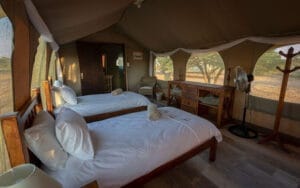


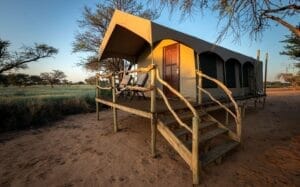






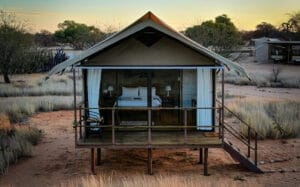
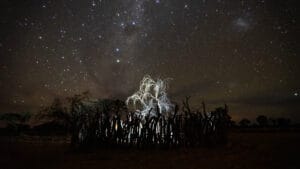
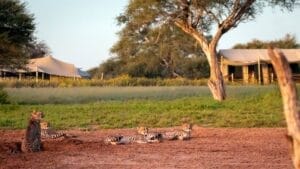



Why Choose Working with Wildlife for Your Kalahari Conservation Safari
When it comes to making a positive impact through travel, Working with Wildlife offers a Kalahari conservation safari experience unlike any other. Here’s what sets us apart:
- Active Conservation on a Grand Scale: Partner with us on South Africa’s largest private big-5 game reserve, Khamab Kalahari Reserve, for this Kalahari conservation safari. It’s not just viewing endangered species, it’s collecting the scientific data vital to save them.
- Beyond the Big 5: Track iconic African wild dogs, aid research on critically endangered pangolins, and spot unique species adapted to the Kalahari. No rigid schedules, just an immersive, data-driven journey.
- Science, Not Crowds: Swap packed jeep tours for hands-on research alongside a small team, with your contributions on this Kalahari conservation safari making a tangible difference.
- Comfort in the Wild: Enjoy the best of both worlds – intimate tented accommodations right in the action, plus modern comforts like hot water and electricity.
- Conservation Ethos: Your Kalahari conservation safari directly funds crucial conservation efforts. Forget guilt-trips about ethics – we prove responsible tourism can be impactful tourism.
Book Now
Ready to start your Kalahari conservation Safari? Contact us today!
More questions, read our FAQs or our Testimonials.
















